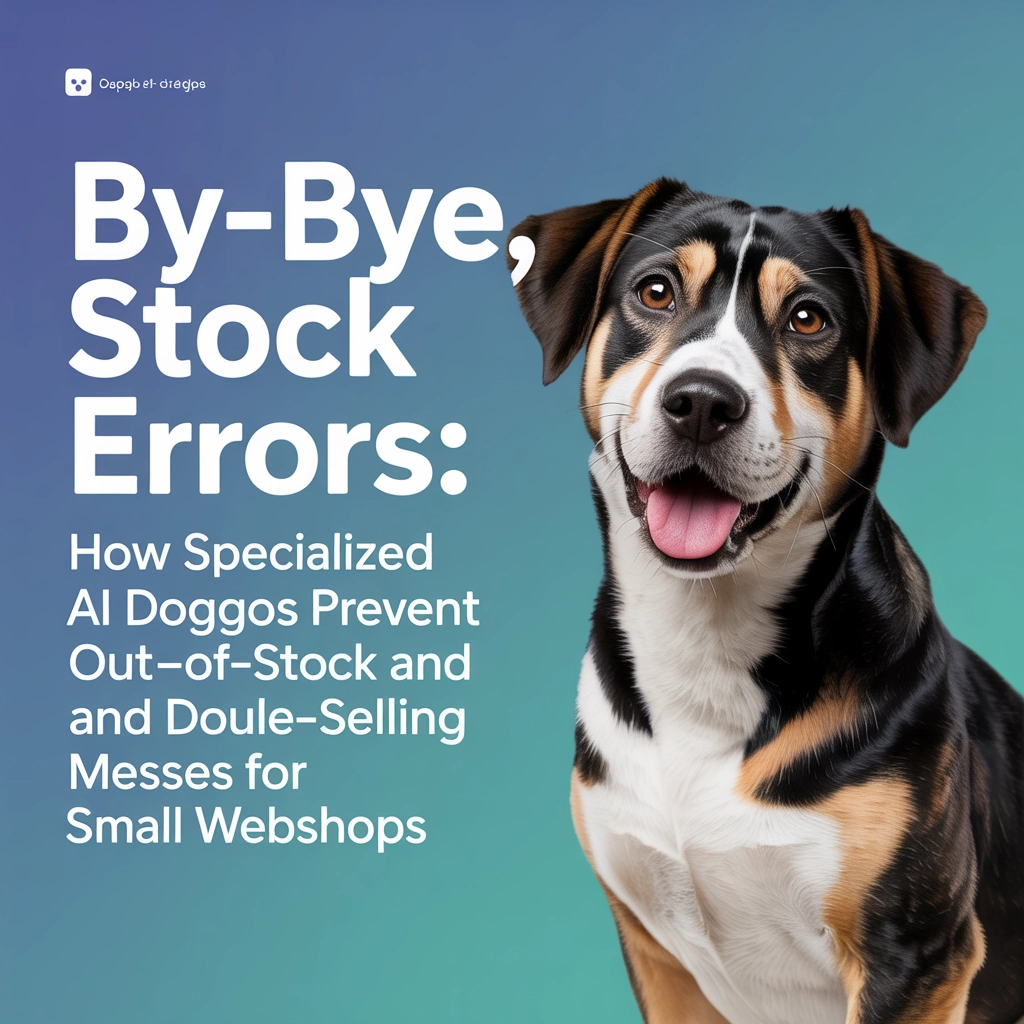Bye-Bye, Stock Errors: How Specialized AI Doggos Prevent Out-of-Stock and Double-Selling Messes for Small Webshops
Stop losing sleep over inventory nightmares. Learn how AI assistants can eliminate stock errors and boost your e-commerce revenue by 12%.

 🐾
🐾Bye-Bye, Stock Errors: How Specialized AI Doggos Prevent Out-of-Stock and Double-Selling Messes for Small Webshops

The Inventory Nightmare Keeping Small Shop Owners Up at Night
It's 2:37 AM. You jolt awake in a cold sweat, grabbing your phone to check if that nightmare was real. Yep—three angry customer emails about items they ordered that are actually out of stock. Worse yet, two customers somehow managed to purchase the last unit of your bestseller. Now you're facing refunds, apologies, and damage control instead of growing your business.
Sound familiar? For small webshop owners, inventory management isn't just a backend operation—it's the invisible foundation that can either support growth or cause your entire business to crumble.
The statistics paint a painful picture: small ecommerce businesses lose an average of 12% in annual revenue to stockout situations. Meanwhile, the customer impact is even more devastating—91% of shoppers won't return after a poor inventory experience like receiving a "sorry, we oversold" email.
"I was manually updating inventory across Shopify, Etsy, and Amazon every night," says Mira Chen, owner of Lunar Craft Supplies. "It was unsustainable, and errors were inevitable. I was essentially playing inventory whack-a-mole."
Where Traditional Inventory Systems Fall Short
Traditional inventory management is like trying to herd cats. Here's where the system typically breaks down for small shops:
- Multi-channel chaos: When you sell on Shopify plus marketplaces like Amazon, Etsy or eBay, inventory sync delays create windows for overselling
- Delayed reactions: By the time you notice a stockout, you've already disappointed customers and lost sales
- Forecasting guesswork: Without advanced analytics, ordering decisions become expensive gambles
- Manual bottlenecks: Small teams can't monitor inventory 24/7, creating vulnerability during high-traffic periods
- Platform limitations: Built-in tools often lack the sophistication needed for complex inventory scenarios
The worst part? These problems compound as your business grows, turning what should be exciting expansion into a operational nightmare.

Enter the AI Inventory Assistant: Your Digital Stock Manager
This is where specialized AI assistants (or as we like to call them at Tailforce, "Doggos") come into play—these aren't just automation tools but intelligent companions that monitor, predict, and protect your inventory around the clock.
Unlike general-purpose chatbots, inventory AI assistants are purpose-built with specific capabilities:
1. Real-Time Multi-Channel Synchronization
AI inventory assistants act as vigilant intermediaries between all your sales channels, ensuring what's available on Shopify matches precisely what's available on Amazon, Instagram Shopping, or your physical store.
How it works:
- Universal inventory ledger: Creates a single source of truth across all platforms
- Transaction buffering: Temporarily reserves inventory during checkout to prevent double-sells
- Cross-platform monitoring: Detects and resolves discrepancies in seconds, not hours
- Webhooks and API connections: Integrates deeply with each platform's native inventory systems
"Since implementing our AI inventory assistant, our cross-platform selling errors have dropped to zero," reports Jake Sullivan, owner of Outdoor Gearheads. "It's like having a superhuman employee who never sleeps and works exclusively on keeping our stock numbers accurate."
2. Predictive Analytics That Prevent Stockouts
Perhaps the most impressive capability of these AI assistants is their ability to see stock problems before they happen.
Rather than simply alerting you when items reach a predetermined threshold, AI inventory systems:
- Analyze seasonal patterns to adjust reorder timing automatically
- Monitor supply chain disruptions that might affect specific products
- Track velocity changes after marketing campaigns or social media mentions
- Consider weather patterns, regional trends, and even competitive pricing
"Our AI assistant flagged that our supplier was taking progressively longer to fulfill orders over three months," explains Tasha Rodriguez of Happy Home Essentials. "It automatically adjusted our reorder points for those items, preventing what would have been a disastrous stockout during our busiest season."

3. Automated Purchasing Workflows
For many products, especially staples and consistent sellers, AI assistants can take inventory management full circle by automating the replenishment process:
- Smart reordering: Generates purchase orders when inventory reaches optimized thresholds
- Supplier management: Tracks performance metrics to help you identify reliable vendors
- Order splitting: Distributes orders across multiple suppliers based on availability, price, and reliability
- Budget management: Staggers purchase orders to optimize cash flow without risking stockouts
While most shop owners start with monitoring features, these automated purchasing workflows often deliver the biggest ROI, freeing up hours each week previously spent on purchase orders.
Real Results: The Numbers Don't Lie
Small businesses implementing AI inventory assistants typically see:
- 94% reduction in out-of-stock situations
- 98% decrease in double-selling incidents
- 23% average increase in inventory turnover rate
- 15-20% reduction in overall inventory holding costs
- 4.7 hours saved weekly on manual inventory tasks
"My inventory used to be my biggest stressor," says independent jeweler Marta Klein. "Now it's actually a competitive advantage. I can carry more variety with less capital tied up in excess stock, and my customers never face disappointment."

Getting Started: Implementing Your AI Inventory Assistant
If you're ready to say goodbye to inventory headaches, here's a simplified roadmap to implementing AI inventory management:
Step 1: Assess Your Current Pain Points
Before choosing a solution, document your specific inventory challenges. Are you primarily struggling with multi-channel syncing? Forecasting? Supplier management? The right system addresses your particular weak spots.
Step 2: Choose the Right Solution
Look for these features in an AI inventory assistant:
- Native integrations with your existing platforms (Shopify, WooCommerce, etc.)
- API access for custom connections
- Scalable pricing that grows with your business
- Mobile alerts and dashboard
- Minimal setup complexity
Step 3: Clean Your Data
AI systems are only as good as the data they analyze. Before implementation:
- Reconcile physical inventory with digital records
- Standardize SKUs and product attributes
- Clear out ghost inventory and zombie listings
- Establish accurate lead times for all products
Step 4: Start Small and Expand
Begin with your most problematic inventory category or channel. Once you see results, expand to your entire catalog. This approach minimizes disruption and lets you adapt to the new workflow.
Beyond Inventory: The Ripple Effects of AI Assistance
When inventory management stops being a constant fire drill, small business owners report significant improvements in other areas:
- Better customer experience: When customers always get what they ordered, satisfaction and loyalty increase
- Optimized marketing: You can confidently promote products knowing your inventory can handle the demand
- Improved supplier relationships: Predictable ordering patterns make you a preferred customer
- Data-driven expansion: Reliable sales and inventory data guides strategic growth decisions
At Tailforce, we've seen firsthand how specialized AI assistants transform operations for small ecommerce businesses. Our executive and support AI Doggos are designed to handle complex business challenges like inventory management with both intelligence and personality.
The age of manual inventory tracking spreadsheets and middle-of-the-night stock checks is over. Today's small webshops have access to the same advanced AI inventory management capabilities once exclusive to retail giants—without the enterprise price tag or complexity.
Ready to let an AI assistant tackle your inventory challenges? Check out our ecommerce automation strategies or see how other small businesses are scaling their ecommerce operations with specialized AI.
Your inventory can become your competitive advantage rather than your biggest headache. And you might even get to sleep through the night again.
 🐾
🐾